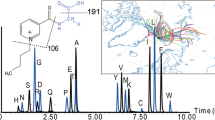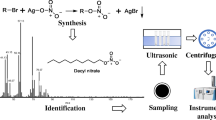Abstract
Methodology for detection of native (underivatized) amino acids (AA) in atmospheric aerosols has been developed. This article describes the use of LC-MS (Q-TOF) and microwave-assisted gas phase hydrolysis for detection of free and combined amino acids in aerosols collected in a Southeastern U.S. forest environment. Accurate mass detection and the addition of isotopically labeled surrogates prior to sample preparation allows for sensitive quantitation of target AA in a complex aerosol matrix. A total of 16 native AA were detected above the reporting threshold as water-soluble free AA, with an average concentration of 22 ± 9 ng m−3 (N = 13). Following microwave-assisted gas phase hydrolysis, the total AA concentration in the forest environment increased significantly (70 ± 35 ng m−3) and additional compounds (methionine, isoleucine) were detected above the reporting threshold. The ability to quantify AA in aerosol samples without derivatization reduces time-consuming preparation procedures while providing the advancement of selective mass determination for important organic nitrogen (ON) species. Details on sample preparation that eliminates the freeze-drying approach typically practiced for water removal with biological samples, and vapor phase microwave hydrolysis parameters are provided. Method application for determination of atmospheric ON is discussed.

Similar content being viewed by others
References
Dittmar T, Fitznar HP, Kattner G (2001) Origin and biogeochemical cycling of organic nitrogen in the eastern Arctic Ocean as evident from d-and l-amino acids. Geochimica et Cosmochimica Acta 65(22):4103–4114
Zhang Q, Anastasio C (2001) Chemistry of fog waters in California’s Central Valley—Part 3: concentrations and speciation of organic and inorganic nitrogen. Atmospheric Environment 35(32):5629–5643
Yu Z, Zhang Q, Kraus T, Dahlgren R, Anastasio C, Zasoski R (2002) Contribution of amino compounds to dissolved organic nitrogen in forest soils. Biogeochemistry 61(2):173–198
Wedyan MA, Preston MR (2008) The coupling of surface seawater organic nitrogen and the marine aerosol as inferred from enantiomer-specific amino acid analysis. Atmospheric Environment 42(37):8698–8705
Altieri KE, Turpin BJ, Seitzinger SP (2009) Composition of dissolved organic nitrogen in continental precipitation investigated by ultra-high resolution FT-ICR mass spectrometry. Environ Sci Technol 43(18):6950–6955
Violaki K, Mihalopoulos N (2010) Water-soluble organic nitrogen (WSON) in size-segregated atmospheric particles over the Eastern Mediterranean. Atmospheric Environment
Ozel MZ, Hamilton JF, Lewis AC (2011) New sensitive and quantitative analysis method for organic nitrogen compounds in urban aerosol samples. Environ Sci Technol 45:1497–1505
Zhang Q, Anastasio C, Jimenez-Cruz M (2002) Water-soluble organic nitrogen in atmospheric fine particles (PM2. 5) from northern California. J Geophys Res 107:4112
Mace KA, Artaxo P, Duce RA (2003) Water-soluble organic nitrogen in Amazon Basin aerosols during the dry (biomass burning) and wet seasons. J Geophys Res 108(D16):4512
Ge X, Wexler AS, Clegg SL (2010) Atmospheric amines-part I. A review. Atmospheric Environment
Castro MS, Driscoll CT, Jordan TE, Reay WG, Boynton WR, Seitzinger SP, Styles RV, Cable JE (2001) Contribution of atmospheric deposition to the total nitrogen loads to thirty-four estuaries on the Atlantic and Gulf coasts of the United States. In: Nitrogen loading in coastal water bodies: an atmospheric perspective. AGU, pp 77–106
Dennis R, Haeuber R, Blett T, Cosby J, Driscoll C, Sickles J, Johnston J (2007) Sulfur and nitrogen deposition on ecosystems in the United States. EM-PITTSBURGH-AIR AND WASTE MANAGEMENT ASSOCIATION-:12
Milne PJ, Zika RG (1993) Amino acid nitrogen in atmospheric aerosols: occurrence, sources and photochemical modification. Journal of Atmospheric Chemistry 16(4):361–398
Neff JC, Holland EA, Dentener FJ, McDowell WH, Russell KM (2002) The origin, composition and rates of organic nitrogen deposition: a missing piece of the nitrogen cycle? Biogeochemistry 57(1):99–136
Cornell S, Jickells T, Cape J, Rowland A, Duce R (2003) Organic nitrogen deposition on land and coastal environments: a review of methods and data. Atmospheric Environment 37(16):2173–2191
Burns DA (2003) Atmospheric nitrogen deposition in the Rocky Mountains of Colorado and southern Wyoming—a review and new analysis of past study results. Atmospheric Environment 37(7):921–932
Chan MN, Choi MY, Ng NL, Chan CK (2005) Hygroscopicity of water-soluble organic compounds in atmospheric aerosols: amino acids and biomass burning derived organic species. Environ Sci Technol 39(6):1555–1562
de Haan DOD, Corrigan AL, Smith KW, Stroik DR, Turley JJ, Lee FE, Tolbert MA, Jimenez JL, Cordova KE, Ferrell GR (2009) Secondary organic aerosol-forming reactions of glyoxal with amino acids. Environ Sci Technol 43(8):2818–2824
Saxena P, Hildemann LM (1996) Water-soluble organics in atmospheric particles: a critical review of the literature and application of thermodynamics to identify candidate compounds. Journal of Atmospheric Chemistry 24(1):57–109
Collett JL, Hoag KJ, Rao X, Pandis SN (1999) Internal acid buffering in San Joaquin Valley fog drops and its influence on aerosol processing. Atmospheric Environment 33(29):4833–4847
Laskin A, Smith JS, Laskin J (2009) Molecular characterization of nitrogen-containing organic compounds in biomass burning aerosols using high-resolution mass spectrometry. Environ Sci Technol 43(10):3764–3771
Laskin J, Laskin A, Roach PJ, Slysz GW, Anderson GA, Nizkorodov SA, Bones DL, Nguyen LQ (2010) High-resolution desorption electrospray ionization mass spectrometry for chemical characterization of organic aerosols. Anal Chem 82(5):2048–2058
Mopper K, Zika RG (1987) Free amino acids in marine rains: evidence for oxidation and potential role in nitrogen cycling. Nature 325(6101):246–249
Kuznetsova M, Lee C, Aller J (2005) Characterization of the proteinaceous matter in marine aerosols. Mar Chem 96(3–4):359–377
Tong Y, Lighthart B (2000) The annual bacterial particle concentration and size distribution in the ambient atmosphere in a rural area of the Willamette Valley, Oregon. Aerosol Science and Technology 32(5):393–403
Scheller E (2001) Amino acids in dew-origin and seasonal variation. Atmospheric Environment 35(12):2179–2192
Sattler B, Puxbaum H, Psenner R (2001) Bacterial growth in supercooled cloud droplets. Geophys Res Lett 28(2):239–242
Mandalakis M, Apostolaki M, Stephanou EG (2010) Trace analysis of free and combined amino acids in atmospheric aerosols by gas chromatography-mass spectrometry. Journal of Chromatography A 1217(1):143–150
Tsugita A, Uchida T, Mewes HW, Ataka T (1987) A rapid vapor-phase acid (hydrochloric acid and trifluoroacetic acid) hydrolysis of peptide and protein. J Biochem 102(6):1593
Keil RG, Kirchman DL (1991) Dissolved combined amino acids in marine waters as determined by a vapor-phase hydrolysis method. Mar Chem 33(3):243–259
Mandalakis M, Apostolaki M, Tziaras T, Polymenakou P, Stephanou EG (2010) Free and combined amino acids in marine background atmospheric aerosols over the Eastern Mediterranean. Atmospheric Environment
Petritis K, Chaimbault P, Elfakir C, Dreux M (2000) Parameter optimization for the analysis of underivatized protein amino acids by liquid chromatography and ionspray tandem mass spectrometry. Journal of Chromatography A 896(1–2):253–263
Qu J, Wang Y, Luo G, Wu Z, Yang C (2002) Validated quantitation of underivatized amino acids in human blood samples by volatile ion-pair reversed-phase liquid chromatography coupled to isotope dilution tandem mass spectrometry. Anal Chem 74(9):2034–2040
Piraud M, Vianey Saban C, Petritis K, Elfakir C, Steghens JP, Morla A, Bouchu D (2003) ESI MS/MS analysis of underivatised amino acids: a new tool for the diagnosis of inherited disorders of amino acid metabolism. Fragmentation study of 79 molecules of biological interest in positive and negative ionisation mode. Rapid Communications in Mass Spectrometry 17(12)):1297–1311
Piraud M, Vianey Saban C, Bourdin C, Acquaviva Bourdain C, Boyer S, Elfakir C, Bouchu D (2005) A new reversed phase liquid chromatographic/tandem mass spectrometric method for analysis of underivatised amino acids: evaluation for the diagnosis and the management of inherited disorders of amino acid metabolism. Rapid Communications in Mass Spectrometry 19(22):3287–3297
Piraud M, Vianey Saban C, Petritis K, Elfakir C, Steghens JP, Bouchu D (2005) Ion pairing reversed phase liquid chromatography/electrospray ionization mass spectrometric analysis of 76 underivatized amino acids of biological interest: a new tool for the diagnosis of inherited disorders of amino acid metabolism. Rapid Communications in Mass Spectrometry 19(12):1587–1602
Zwiener C, Frimmel FH (2004) LC-MS analysis in the aquatic environment and in water treatment—a critical review. Anal Bioanal Chem 378(4):851–861
Pérez S, Eichhorn P, Barceló D (2007) Structural characterization of photodegradation products of enalapril and its metabolite enalaprilat obtained under simulated environmental conditions by hybrid quadrupole-linear ion trap-MS and quadrupole-time-of-flight-MS. Anal Chem 79(21):8293–8300
Hollender J, Singer H, Hernando D, Kosjek T, Heath E (2010) The challenge of the identification and quantification of transformation products in the aquatic environment using high resolution mass spectrometry. Xenobiotics in the Urban Water Cycle:195–211
Erisman JW, Draaijers G, Duyzer J, Hofschreuder P, Leeuwen NV, Römer F, Ruijgrok W, Wyers P, Gallagher M (1997) Particle deposition to forests—summary of results and application. Atmospheric Environment 31(3):321–332
Fenn ME, Poth MA, Aber JD, Baron JS, Bormann BT, Johnson DW, Lemly AD, McNulty SG, Ryan DF, Stottlemyer R (1998) Nitrogen excess in North American ecosystems: predisposing factors, ecosystem responses, and management strategies. Ecol Appl 8(3):706–733
Lin M, Walker J, Geron C, Khlystov A (2010) Organic nitrogen in PM2. 5 aerosol at a forest site in the Southeast US. Atmos Chem Phys 10:2145–2157
Geron C (2009) Carbonaceous aerosol over a Pinus taeda forest in Central North Carolina, USA. Atmospheric Environment 43(4):959–969
Swartz E, Stockburger L, Gundel LA (2003) Recovery of semivolatile organic compounds during sample preparation: implications for characterization of airborne particulate matter. Environ Sci Technol 37(3):597–605
Fountoulais M, Hans-Werner L (1998) Hydrolysis and amino acid composition analysis of proteins. Journal of Chromatography A 826:109–134
Confer DR, Logan BE, Aiken BS, Kirchman DL (1995) Measurement of dissolved free and combined amino acids in unconcentrated wastewaters using high performance liquid chromatography. Water Environment Research 67(1):118–125
Zhang Q, Anastasio C (2003) Free and combined amino compounds in atmospheric fine particles (PM2. 5) and fog waters from Northern California. Atmospheric Environment 37(16):2247–2258
Gilman LB, Woodward C (1990) An evaluation of microwave heating for the vapor phase hydrolysis of proteins. Current research in protein chemistry: techniques, structure, and function. Academic, San Diego, pp 23–36
Margolis SA, Jassie L, Kingston H (1991) The hydrolysis of proteins by microwave energy. J Autom Chem 13(3):93
Peter A, Laus G, Tourwe D, Gerlo E, Van Binst G (1993) An evaluation of microwave heating for the rapid hydrolysis of peptide samples for chiral amino acid analysis. Peptide Research 6:48–48
Tatár E, Khalifa M, Záray G, Molnár-Perl I (1994) Comparison of the recovery of amino acids in vapour-phase hydrolysates of proteins performed in a Pico Tag work station and in a microwave hydrolysis system. Journal of Chromatography A 672(1–2):109–115
Marconi E, Panfili G, Bruschi L, Vivanti V, Pizzoferrato L (1995) Comparative study on microwave and conventional methods for protein hydrolysis in food. Amino Acids 8(2):201–208
Lill JR, Ingle ES, Liu PS, Pham V, Sandoval WN (2007) Microwave assisted proteomics. Mass Spectrometry Reviews 26(5):657–671
Nakashima T, Higa H, Matsubara H, Benson AM, Yasunobu KT (1966) The amino acid sequence of bovine heart cytochrome c. J Biol Chem 241(5):1166
Snyder LR, Glajch JL, Kirkland JJ (1997) Practical HPLC method development. Wiley New York etc.
Skoog AA, Leary JJ (1992) Principles of instrument analysis, 4th edn. Saunders, Orlando
Laskin A, Lechevalier HA (1982) CRC handbook of microbiology: microbial composition: amino acids, proteins, and nucleic acids. In, vol III, 3rd edn. CRC, Boca Raton
Spoelstra SF (1978) Degradation of tyrosine in anaerobically stored piggery wastes and in pig feces. Appl Environ Microbiol 36(5):631
O’Donnell TH, Macko SA, Wehmiller JF (2007) Stable carbon isotope composition of amino acids in modern and fossil Mercenaria. Org Geochem 38(3):485–498
Acknowledgments
The authors would like to thank John T. Walker and Chris Geron for assistance in sample collection. Additional funding for this research was provided through a U.S. Department of Energy interagency agreement administered by the Oak Ridge Institute for Science and Education (ORISE).
Author information
Authors and Affiliations
Corresponding author
Additional information
Published in the special issue Aerosol Analysis with guest editor Ralf Zimmermann.
Rights and permissions
About this article
Cite this article
Samy, S., Robinson, J. & Hays, M.D. An advanced LC-MS (Q-TOF) technique for the detection of amino acids in atmospheric aerosols. Anal Bioanal Chem 401, 3103–3113 (2011). https://doi.org/10.1007/s00216-011-5238-2
Received:
Revised:
Accepted:
Published:
Issue Date:
DOI: https://doi.org/10.1007/s00216-011-5238-2




